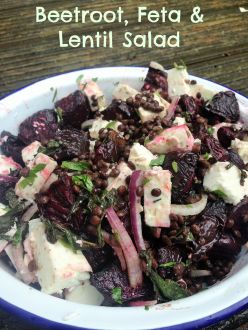The Ploughman’s lunch is a British classic, and appears in many guises on the menus of pubs and cafes across the country. Whether it is steeped in tradition is debateable, but there is no doubt that the combination of bread, cheese, chutney and pickles is a winner. Teamed with a pint in a sunny pub garden, there is little better to consume on a spring lunchtime. So, when looking for something to take to the allotment for lunch, I often end up creating something Ploughman’s like. It is a real favourite of mine.
Merrydown cider recently gave me a couple of bottles and invited me to create a Ploughman’s as part of a Sussex food blogger challenge; so ever eager to promote local ingredients, I created this Sussex version of the classic. I prefer a cheese ploughman’s, so a bit of the wonderful Sussex Charmer is a must. Produced by Bookham Harrison farm, it combines recipes for farmhouse cheddar and parmesan to produce a creamy cheese with a bit of punch.
In terms of a bread, it has to be a crunchy loaf with a good crumb. I’ve long wanted to make a bread using cider, so used some Merrydown as the liquid in a loaf which combines wheat and rye flour. Based on a Richard Bertinet recipe, the result is perfect teamed with the strong flavours of the cheese and chutney.

Cider Bread
You will need (makes one large loaf)
Pre-ferment
100g strong white flour
25g light rye flour
2g yeast
2g salt
90g water
Main bread mix
3g yeast
250g strong white flour
5g salt
150g good cider (I used Merrydown)
Start by making your pre-ferment by combining the ingredients together, kneading a little, then leaving for 6 hours or so. This helps to give a mature flavour to the bread. After this initial ferment; mix with the remaining ingredients and knead for 5-10 minutes until the dough is smooth and elastic. Shape into a ball and place it back into a bowl, cover with a tea towel or plastic and leave to prove for a further 45-60 minutes.
When the dough has proved for nearly an hour, remove from the bowl and shape into a batard. I placed mine in a banneton, but a floured tea towel would be fine. Cover and leave to prove for 1 and half hours, or until the loaf has nearly doubled in volume. To bake, turn the loaf onto peel (or the floured back of a baking tray), spray the inside of the oven with water, and then slide the loaves onto a preheated (240°C) baking stone or tray. Bake for 10 minutes, then turn down the heat to 200°C, and bake for about 35 minutes until well coloured. The loaf should be hollow in sound when tapped. Allow to cool before slicing.
Apple & Cider Chutney
You will need (makes one large jar)
100g sultanas
1 pint cider (I used Merrydown Sussex Cider)
4 eating apples, peeled and chopped (there are lots of great varieties from Sussex, with my friends at Brighton Pemaculture Trust working hard to preserve them).
3 onions, finely chopped
1 cup granulated sugar
1/2 cup soft brown sugar
1 cup cider vinegar
1/2 tsp peppercorns
1/2 cinnamon stick
1/4 tsp chilli flakes
1 tsp coriander seeds
1 star anise
Start by soaking the sultanas in the cider overnight. In the morning, place the spices into a muslin bag and secure tightly. Put all the ingredients, including the sultanas with cider, into a large heavy based pan and bring to the boil. Turn down and simmer for a couple of hours, until the mixture achieves a sticky chutney consistency and the surplus watery liquid has evaporated. Whilst still hot put into sterilised jar and allow to cool.
 As Autumn shows its true colours, with beautiful ruddy leaves appearing on the trees, I’m inspired to get back to the allotment with some regularity. Being outside is always beneficial to my wellbeing, and I sometimes need to be reminded of how it can help me. I think with weather set to be fine for the weekend, a trip to the plot is needed.
As Autumn shows its true colours, with beautiful ruddy leaves appearing on the trees, I’m inspired to get back to the allotment with some regularity. Being outside is always beneficial to my wellbeing, and I sometimes need to be reminded of how it can help me. I think with weather set to be fine for the weekend, a trip to the plot is needed.


 The kit comes with all the spices and gram flour combined, and instuctions to make both vegetable and paneer pakora. There’s also a link to a video showing the process involved, but the recipe on the card is clear and easy to follow. As mentioned before, pakora are very versatile, so I chose to use up a glut of courgettes, as well as some potatoes and onions. I love growing courgettes at the allotment, but if you look away for a moment, they seem to grow in seconds, so another way to use them up is always handy. The one thing with using courgettes is that they have a lot of liquid in them, so after grating them they need to be squeezed of excess water, before combining them with the rest of the mix. Once your mixture is combined, it needs to be used pretty quickly, dropping spoonfuls into hot oil and frying until golden brown.
The kit comes with all the spices and gram flour combined, and instuctions to make both vegetable and paneer pakora. There’s also a link to a video showing the process involved, but the recipe on the card is clear and easy to follow. As mentioned before, pakora are very versatile, so I chose to use up a glut of courgettes, as well as some potatoes and onions. I love growing courgettes at the allotment, but if you look away for a moment, they seem to grow in seconds, so another way to use them up is always handy. The one thing with using courgettes is that they have a lot of liquid in them, so after grating them they need to be squeezed of excess water, before combining them with the rest of the mix. Once your mixture is combined, it needs to be used pretty quickly, dropping spoonfuls into hot oil and frying until golden brown.




































 Pizza is undoubtedly one of my favourite foods and a sure fire winner with the kids too. There are so many possible things to top it with, but almost always they include the addition of a tomato sauce on the base. I do love this classic pizza, but I’ve recently discovered the pizza bianca; a pizza with no tomato. Somehow the lack of the tomato allows you to really appreciate the flavours of the pizza topping fully.
Pizza is undoubtedly one of my favourite foods and a sure fire winner with the kids too. There are so many possible things to top it with, but almost always they include the addition of a tomato sauce on the base. I do love this classic pizza, but I’ve recently discovered the pizza bianca; a pizza with no tomato. Somehow the lack of the tomato allows you to really appreciate the flavours of the pizza topping fully.



